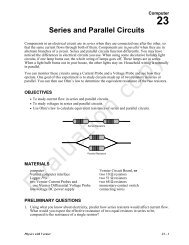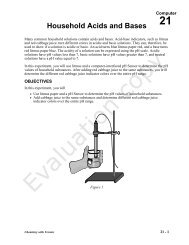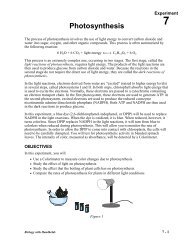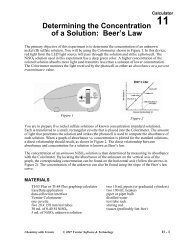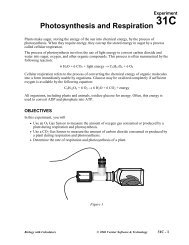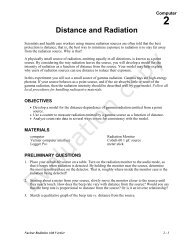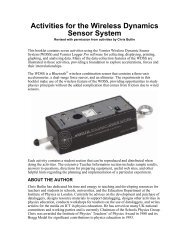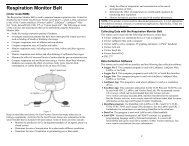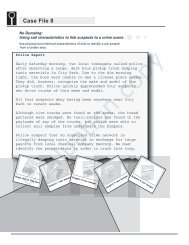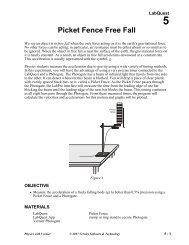Enzyme Action: Testing Catalase Activity - Vernier Software ...
Enzyme Action: Testing Catalase Activity - Vernier Software ...
Enzyme Action: Testing Catalase Activity - Vernier Software ...
You also want an ePaper? Increase the reach of your titles
YUMPU automatically turns print PDFs into web optimized ePapers that Google loves.
TEACHER INFORMATION<strong>Enzyme</strong> <strong>Action</strong>:<strong>Testing</strong> <strong>Catalase</strong> <strong>Activity</strong>Experiment6A1. The student pages with complete instructions for data-collection using LabQuest App,Logger Pro (computers), EasyData or DataMate (calculators), and DataPro (Palm handhelds)can be found on the CD that accompanies this book. See Appendix A for more information.2. This experiment may take a single group several lab periods to complete. A good breakingpoint is after the completion of Step 10, when students have tested the effect of differentenzyme concentrations. Alternatively, if time is limited, different groups can be assigned oneof the three tests and the data can be shared.3. Your hot tap water may be in the range of 50-55°C for the hot-water bath. If not, you maywant to supply pre-warmed temperature baths for Part II, where students need to maintainvery warm water. Warn students not to touch the hot water.4. Many different organisms may be used as a source of catalase in this experiment. If enzymesfrom an animal, a protist, and a plant are used by different teams in the same class, it will bepossible to compare the similarities and differences among those organisms. Often, eitherbeef liver, beef blood, or living yeast are used.5. To prepare the yeast solution, dissolve 7 g (1 package) of dried yeast per 100 mL of 2%glucose solution. A 2% glucose is made by adding 20 g of glucose to enough distilled waterto make 1 L of solution. Incubate the suspension in 37 – 40°C water for at least 10 minutes toactivate the yeast. Test the experiment before the students begin. The yeast may need to bediluted if the reaction occurs too rapidly. The reaction in Step 4, with 6 mL of 1.5% hydrogenperoxide, and 5 drops of suspension produces enough oxygen to exceed a measuredconcentration of 22% in 40 to 60 seconds.6. To prepare a liver suspension, homogenize 0.5 to 1.5 g of beef liver in 100 mL of cold water.You will need to test the suspension before use, as its activity varies greatly depending on itsfreshness. Dilute the suspension until the reaction in Step 4, with 6 mL of 1.5% hydrogenperoxide, and 5 drops of suspension produces enough oxygen to exceed a measuredconcentration of 22 % in 40 to 60 seconds. The color of the suspension will be a faint pink.Keep the suspension on ice until used in an experiment.7. 3% H 2 O 2 may be purchased from any supermarket. If refrigerated, bring it to roomtemperature before starting the experiment.8. To extend the life of the O 2 Gas Sensor, always store the sensor upright in the box in which itwas shipped.9. <strong>Vernier</strong> <strong>Software</strong> sells a pH buffer package for preparing buffer solutions with pH values of4, 7, and 10 (order code PHB). Simply add the capsule contents to 100 mL of distilled water.10. You can also prepare pH buffers using the following recipes:• pH 4: Add 2.0 mL of 0.1 M HCl to 1000 mL of 0.1 M potassium hydrogen phthalate.• pH 7: Add 582 mL of 0.1 M NaOH to 1000 mL of 0.1 M potassium dihydrogen phosphate.• pH 10: Add 214 mL of 0.1 M NaOH to 1000 mL of 0.05 M sodium bicarbonate.Biology with <strong>Vernier</strong>6A - 1 T




